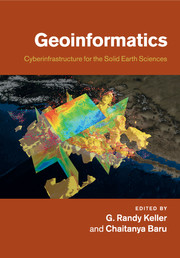Book contents
- Frontmatter
- Contents
- List of contributors
- Preface
- Introduction
- Part I Case studies from other disciplines
- Part II Modeling software and community codes
- Part III Visualization and data representation
- 8 Visualization of seismic model data
- 9 The UNAVCO GEON Integrated Data Viewer for exploration, analysis, and integration of geoscience data
- Part IV Knowledge management and data integration
- Part V Web services and scientific workflows
- Part VI Emerging international and other efforts
- Index
- Plate section
- References
8 - Visualization of seismic model data
from Part III - Visualization and data representation
Published online by Cambridge University Press: 25 October 2011
- Frontmatter
- Contents
- List of contributors
- Preface
- Introduction
- Part I Case studies from other disciplines
- Part II Modeling software and community codes
- Part III Visualization and data representation
- 8 Visualization of seismic model data
- 9 The UNAVCO GEON Integrated Data Viewer for exploration, analysis, and integration of geoscience data
- Part IV Knowledge management and data integration
- Part V Web services and scientific workflows
- Part VI Emerging international and other efforts
- Index
- Plate section
- References
Summary
Introduction
Computational modeling and simulations are becoming popular test beds and proving grounds in several areas of science. The seismology community is no exception to this trend, and the increased capability and availability of computational power has fueled further interest in performing such simulations using models. Over the last two decades, scientists have been making steady improvements to computational models, and we are just beginning to see the results of their efforts. The current models are capable of running on a variety of computational resources at multiple scales and sizes. One approach for studying the simulation models is by creating probable earthquake scenarios. These simulations require considerable computational and storage capacity for a successful run, and the amount of data produced by these simulations is enormous, requiring a non-trivial amount of processing for analysis of the results. Traditional analysis of model outputs, using statistical summarizations or simple examination of output data is impractical. Visualization offers an alternative approach for analyzing such huge stockpiles of data.
Visualization characteristics
It is important to identify a few key characteristics that any visualization should possess which can help us in designing and implementing a visualization solution for a given problem. We discuss the role of desirable visualization characteristics including intuitiveness, trainability, focus, interactivity, and accessibility.
- Type
- Chapter
- Information
- GeoinformaticsCyberinfrastructure for the Solid Earth Sciences, pp. 117 - 130Publisher: Cambridge University PressPrint publication year: 2011



